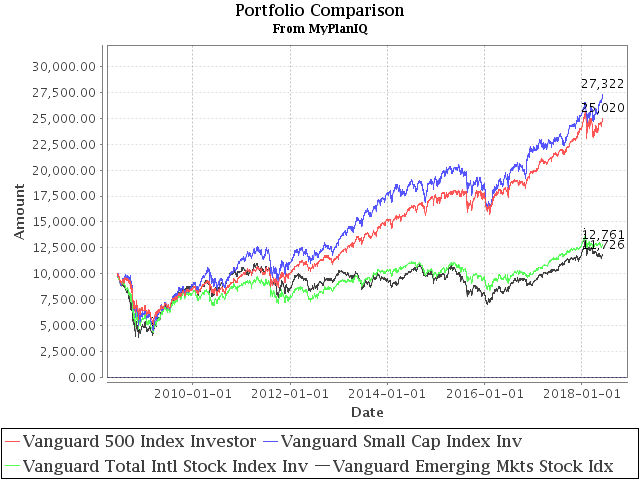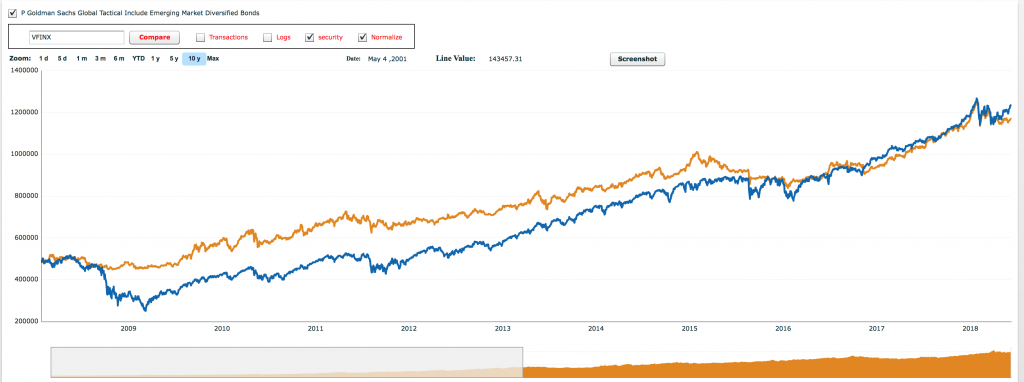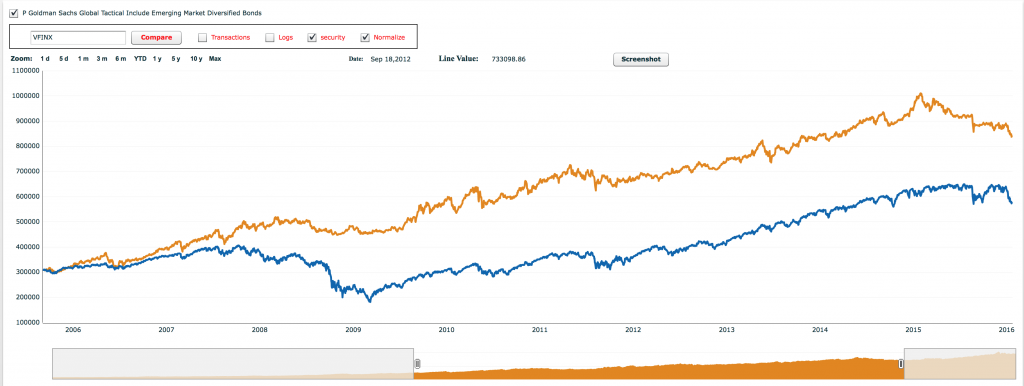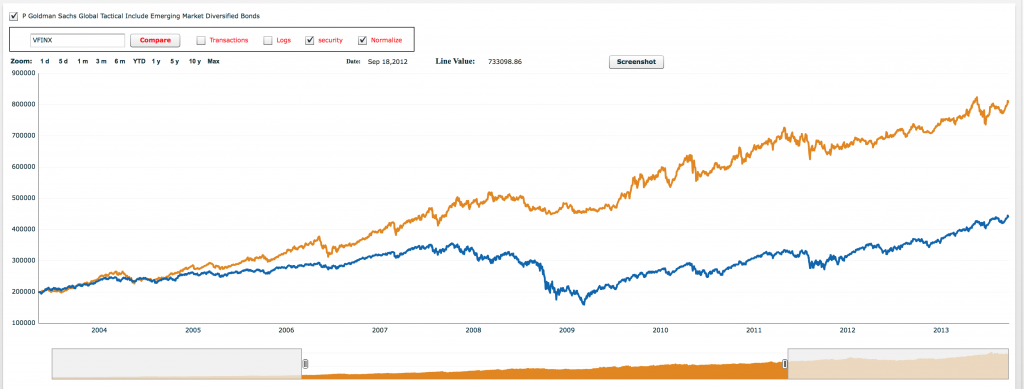Re-balance Cycle Reminder All MyPlanIQ’s newsletters are archived here.
For regular SAA and TAA portfolios, the next re-balance will be on Monday, July 16, 2018. You can also find the re-balance calendar for 2017 on ‘Dashboard‘ page once you log in.
As a reminder to expert users: advanced portfolios are still re-balanced based on their original re-balance schedules and they are not the same as those used in Strategic and Tactical Asset Allocation (SAA and TAA) portfolios of a plan.
Please note that we now list the next re-balance date on every portfolio page.
Is 10 Year Long Enough For Portfolio Comparison?
Current bull market in US stocks has been so consistently stronger than others that it’s becoming increasingly difficult to argue for the benefits of asset allocation or diversification. In this newsletter, however, we try to walk through historical performance and look at current live data (and likely some of your portfolios). We hope this could help us to better understand how to evaluate a portfolio in an often used ‘long term’ period.
Recent stock asset returns
First, let’s compare the major stock asset performance:
| Stock Asset | YTD Return** |
1Yr AR | 3Yr AR | 5Yr AR | 10Yr AR | 15Yr AR | 20 Yr AR |
|---|---|---|---|---|---|---|---|
| VFINX (Vanguard 500 Index Investor) | 4.8% | 16.3% | 12.3% | 13.2% | 9.6% | 9.3% | 6.6% |
| NAESX (Vanguard Small Cap Index Inv) | 8.2% | 19.1% | 10.9% | 12.5% | 10.5% | 11.5% | 8.8% |
| VGTSX (Vanguard Total Intl Stock Index Inv) | 0.2% | 11.0% | 6.3% | 6.4% | 2.5% | 7.9% | 5% |
| VEIEX (Vanguard Emerging Mkts Stock Idx) | -1.1% | 12.8% | 5.6% | 4.5% | 1.6% | 10.7% | 8.3% |
*: NOT annualized
10 Year total return charts:
A couple of observations:
- Clearly for the past 1, 3, 5 and 10 years, US stocks (both large cap and small cap) have done so much better than others.
- However, moving to 15 and 20 years, things become less consistent: emerging market stocks did outperform US large stocks for those periods is mostly because of some earlier years strong returns from emerging market stocks.
While reviewing various portfolios listed on our Advanced Strategies page, especially those that can invest 100% in risk assets (stocks, for example) at some time, we found their recent returns are all over the map. Here are the ones we have regularly featured in our newsletters:
| Ticker/Portfolio Name | YTD Return** |
1Yr AR | 3Yr AR | 5Yr AR | 10Yr AR | 15Yr AR | Since 2001 AR |
|---|---|---|---|---|---|---|---|
| P Goldman Sachs Global Tactical Include Emerging Market Diversified Bonds | 0.8% | 12.9% | 8.4% | 8.4% | 8.8% | 12.3% | 12.8% |
| P Invest and Speculate | 4.8% | 16.3% | 10.8% | 12.3% | 14.4% | 13.3% | 12.8% |
| P Momentum Scoring Style ETFs and Treasuries | 9.0% | 19.1% | 7.1% | 9.3% | 10.0% | 11.3% | 9.4% |
| P Warren Buffett Total Stock Market Valuation to GNP Ratio SO SU Weekly Strategy Total Return Bond Funds As Cash | -2.0% | 0.4% | 4.0% | 7.9% | 12.9% | 11% | 11.1% |
| VFINX (Vanguard 500 Index Investor) | 4.8% | 16.3% | 12.3% | 13.2% | 9.6% | 9.3% | 6.5% |
*: NOT annualized
The reason we chose return data since 1/1/2001 is because most of these portfolios’ start dates began on this date.
The above table includes a global tactical portfolio (P Goldman Sachs Global Tactical), a long term stock valuation metric based timing portfolio (P Warren Buffett) on US stocks, an improved version of the Buffett ratio portfolio (P Invest and Speculate) and a 9 US style (large cap, small cap, growth, value etc.) stock rotation (P Momentum Scoring Style) portfolio.
Several observations:
- S&P 500 total return (represented by VFINX) has excelled for the past 1, 3, 5 years. The reason it lost out for the 10 years is mostly the poor performance from June 2008 to March 2009, a major period of the 2008-2009 bear market. We suspect that if the current trend continues to this time next year, it will outperform most of these portfolios for the 10 year period as by then, the 2008 bear market will not be included anymore.
- Since 2003 (15 year period), however, S&P 500 has returned the least. This is again because of the 2008-2009 bear market as well as some of the outperformance by emerging market stocks and international stocks.
- For more than 17 years, the global diversified portfolio P Goldman Sachs Global Tactical Include Emerging Market Diversified Bonds did the best, along with P Invest and Speculate, a portfolio that combines 200 day moving average timing as well as long term stock valuation metric (using Buffett ratio) on S&P 500, so a US stock centric portfolio.
Global tactical starts to lose steam compared with US stocks for the recent 10 years
Based on the above data, one can see that for 15 and beyond, global diversification based and/or long term timing based portfolios have easily outperformed US stocks. This fact has increasingly been forgotten by investors because of the recent strong 1, 3, 5, and even 10 years’ US stock outperformance.
As stated above, we are seeing right now US stocks (represented by VFINX) has begun to outperform global TAA portfolio P Goldman Sachs Global Tactical Include Emerging Market Diversified Bonds for the 10 year period. We suspect this trend will continue till the next major correction, which is likely to happen next year or maybe as late as 2020 (this is a pure subjective speculation, as always, we don’t very much trust our own prediction/speculation).
However, if we look at our total return flash based chart that compares the total returns of VFINX against that of the global TAA portfolio (please click on 10y (10 year) tab and check Normalized box (meaning relative comparison)), you can move the 10 year period backward (by dragging the slider at the bottom of the chart), and ‘simulate’ or ‘walk’ through rolling 10 year periods since 1998. Here are some snapshot:
The latest 10 year: (Indigo line represents VFINX)
From 2005 to 2016 (the worst year of the P GS portfolio):
From 2003 (out of the 2000-2002 tech induced recession) to 2013:
If you do walk through from right to left, you will see that for virtually all other 10 year periods, the portfolio has outperformed VFINX.
But again, we are seeing now VFINX starts to do better than the portfolio for the last 10 years and probably will continue to do so for a while.
Is 10 year return long enough?
The short answer to this question is no, a 10 year period is probably not long enough. This is not surprising. We addressed so called minimum holding periods for both buy and hold (SAA) and tactical (TAA) portfolios previously:
- For buy and hold stocks, the minimum holding period should be 15 years, preferably 20 years or more.
- For tactical portfolios, the minimum holding period should be 10 years, preferably 15 years or more.
The above statement is about minimum holding period for stock portfolios (i.e. SAA or TAA). By minimum holding periods we mean a period in which your portfolio can give you some reasonable returns over inflation.
On the other hand, for comparison purpose among different strategy based portfolios, from the above data, we would claim that one should give at least 10 years, preferably 15 years or more time if you want to see a tactical strategy based portfolio to show its advantage. The reason is that though in most cases, a 10 year period is sufficiently long enough to cover a complete market cylce (bear and bull or bull and bear market), some bull market alone (like the current one which is 9 plus and running) can be as long as 10 years or so.
To summarize, the above discussion is just to give us some quantitative sense on the often used ‘long term’ phrase. For the absolute inflation beating returns, portfolios should be held for 15 or 20 years more, depending on the types of strategies. On the other hand, for comparison purpose, one should look at relative return data beyond 10 years.
Finally, the above conclusion is at best still a rough estimate. For example, if indeed for the coming 10 years, buy and hold US stocks (like S&P 500 index funds) will give us zeor or even negative annualized return (as predicted by many such as GMO and John Hussman), and only then the valuation is back to a historical normal level (thus achieving 10% annual return for the next 10 years), one should expect buy and hold US stocks for the next 20 years will only give us 4% to 5% annual return ((1.1)^10)^(1/20)-1 = 4.8%).
Market Overview
It’s somewhat surprising that stock markets are still going strong even now we are in the summer session that’s usually weak for stocks. Furthermore, rate sensitive assets such as REITs have recovered somewhat, though not completely. For example, year to date, consumer staples (XLP) sector has returned -8.9% while utilities sector (XLU) returned -6.3% till last Friday. At the moment, there is no visible or imminent recession or downturn risk in economy. However, as we stated many times, things can change quickly in today’s over valued and over extended markets. As always, stay the course and while we still can, enjoy a good market in this summer.
For more detailed asset trend scores, please refer to 360° Market Overview.
Now that the Trump administration has been in the office for more than a year, the economy and financial markets are in general still in a good shape. Whether the economy will continue to benefit from the supposedly trickle down of the tax cut, the deregulation, and the promised infrastructure spending remains to be seen. On the other hand, stocks continued to ascend, regardless of the progress. Looking ahead, however, we remain convinced that markets will experience more volatilities at some point when reality finally sets in.
In terms of investments, U.S. stock valuation is at a historically high level. It is thus not a good time to take excessive risk. However, we remain optimistic about U.S. economy in the long term and believe much better investment opportunities will arise in the future.
We again would like to stress for any new investor and new money, the best way to step into this kind of markets is through dollar cost average (DCA), i.e. invest and/or follow a model portfolio in several phases (such as 2 or 3 months) instead of the whole sum at one shot.
Enjoy Newsletter
How can we improve this newsletter? Please take our survey
–Thanks to those who have already contributed — we appreciate it.
Latest Articles
- June 4, 2018: Action Plan: Risk Review For Investments
- May 21, 2018: Rising Rates, Consumer Staples And Stock Index
- May 14, 2018: Newsletter Collection Update
- May 7, 2018: Money Market Fund Taxonomy
- April 30, 2018: Momentum Investing Review
- April 23, 2018: Commodities In Current Environment
- April 16, 2018: Municipal Bonds As A Fixed Income Asset Class
- April 9, 2018: Exponential Or Compounding Nature In Investing
- April 2, 2018: Inside Of The Stock Chaos
- March 26, 2018: Total Return Bond Update
- March 19, 2018: Treasury Bills vs. Brokered CDs
- March 12, 2018: Defensive Conservative Portfolio Review
- March 5, 2018: Warren Buffett’s Advices
- February 26, 2018: Pros And Cons of Strategic And Tactical Portfolios In 2018
- February 12, 2018: Trend Review
- February 5, 2018: Market Selloff And Long Term Investing
- January 29, 2018: The New Addition To Our Total Return Bond Fund Candidates
- January 22, 2018: Where Are Bonds Heading?
- January 15, 2018: Tactical Portfolios Review
- January 8, 2018: Strategic Portfolios Review
- December 18, 2017: Record Highs And Risk
- December 11, 2017: Cash Return And Interest Rate Update
- December 4, 2017: Mutual Fund Star Ratings: Are They Useful?
- November 20, 2017: Thankful And Mindful
- November 13, 2017: Is This A Good Time For Retirees Or Would Be Retirees?
- November 6, 2017: Newsletter Collection Update
- October 30, 2017: Rising Interest Rates
- October 23, 2017: A Primer For Portfolios
- October 16, 2017: REITs As An Asset Class
- October 9, 2017: Conservative Portfolios Revisited
- October 2, 2017: The Role of Short Term Bond Funds
- September 25, 2017: Fees In Cash Investments
- September 18, 2017: Conservative Portfolios Review
- September 11, 2017: International Diversification Effect
- September 4, 2017: Invest And Speculate Revisited
- August 28, 2017: Total Return Bond Fund Portfolios: Where Do They Fit?
- August 21, 2017: Portfolio Performance: A Walk In The Past
- August 14, 2017: Fidelity Commission Free ETFs Update
- August 7, 2017: I Didn’t Learn Anything — Mistake vs. Temporary Underperformance
- July 31, 2017: Asset Classes And Fund Choices: A Primer
- July 24, 2017: Total Return Bond Fund Portfolios And Cash
- July 17, 2017: Long Term Stock Holding Periods For Retirement
- July 10, 2017: Half Year Asset Trend Review
- June 26, 2017: How To Beat The Best Balanced Allocation Fund
- June 19, 2017: Newsletter Collection Update
- June 12, 2017: A Mixed Bag Performance of Momentum Investing
- June 5, 2017: How To Start A New Portfolio
- May 29, 2017: Alternative Assets And Their Role In Portfolios
- May 22, 2017: Summer Seasonality And Portfolio Management
- May 15, 2017: Cash: Banking Or Investing?
- May 8, 2017: Holding Period of Long Term Timing Portfolios
- May 1, 2017: Debate on Risk vs. Volatility
- April 24, 2017: The Long Term Stock Market Timing Return Since 1871
- April 17, 2017: Risk vs. Volatility: Long Term Stock Market Returns
- April 10, 2017: Total Return Bond ETFs And Portfolios
- April 3, 2017: Quarter End Asset Trend Review
- March 27, 2017: Practical Consideration For IRAs And 401k Accounts
- March 20, 2017: Fund Fees: That’s (Still) Outrageous
- March 13, 2017: Long Term Stock Valuation Review
- March 6, 2017: Asset Classes for Retirement Investments
- February 27, 2017: Fidelity Total Bond Fund Review
- February 20, 2017: Long Term Stock Timing Based Portfolios And Their Roles
- February 13, 2017: Alternative Investment Portfolios Review
- February 6, 2017: Tax Free Municipal Bond Investments Review
- January 30, 2017: Brokerage Specific Conservative Portfolios
- January 23, 2017: Fixed Income Portfolio Review
- January 16, 2017: Long Term Trend Following Portfolio Review
- January 9, 2017: Tactical Asset Allocation Review
- January 3, 2017: Strategic Asset Allocation Review
- December 12, 2016: Enhanced Index Funds
- December 5, 2016: Review Of Broad Base Core Mutual Funds For Brokerages
- November 28, 2016: Core Index ETFs Review
- November 21, 2016: International Exposure Of U.S. Large Companies
- November 14, 2016: Asset Trends After The Election
- November 7, 2016: Rising Rate And Current Bond Trend
- October 31, 2016: Economy Power And Long Term Stock Returns
- October 24, 2016: Current Commodity Trend And Managed Futures
- October 17, 2016: Investment Mistakes And Good Or Bad Investment Strategies
- October 10, 2016: Momentum Investing Review
- October 3, 2016: Survey & Feedback
- September 26, 2016: Fixed Income Investing: Actively Managed Funds vs. Index Funds
- September 19, 2016: Stock Investing: Actively Managed Funds vs. Index Funds
- September 12, 2016: Newsletter Update
- September 5, 2016: Overvalued Markets And Long Term Timing Strategies
- August 29, 2016: Your 401K Finally Draws Attention
- August 22, 2016: Inflation Protected Securities TIPS For Current Overvalued Markets
- August 15, 2016: Risk On: Emerging Market Stocks And Small Cap Stocks
- August 8, 2016: Portfolio Construction Using Stock ETFs And Bond Mutual Funds
- August 1, 2016: Adding Value To Your Own Investments
- July 25, 2016: Tactical Asset Allocation Funds Review
- July 18, 2016: Strategic Asset Allocation & Lazy Portfolio Review
- July 11, 2016: Asset Trend Review
- June 27, 2016: Secular Cycles For Tactical And Strategic Investment Strategies
- June 20, 2016: A World of Debt
- June 13, 2016: Managed Futures For Portfolio Building
- June 6, 2016: Newsletter Summary
- May 30, 2016: Swensen Portfolio And Permanent Portfolios
- May 23, 2016: AAII Article And Some Web Changes
- May 16, 2016: The PIMCO (Dis)Advantages
- May 9, 2016: Boost Your Dull Summer Investments
- May 2, 2016: Low Cost Index Fund Investing
- April 25, 2016: Tax Free Municipal Bond Funds & Portfolios
- April 18, 2016: Asset Class Trend Review
- April 11, 2016: Construction of Sound And Conservative Portfolios
- March 28, 2016: Total Return Bond ETFs Review
- March 21, 2016: Small And Large Company Stock Performance In Different Economic Expansion Cycles
- March 14, 2016: Are Tactical And Timing Strategies Losing Steam?
- March 7, 2016: Defined Maturity Bond Fund Analysis
- February 29, 2016: Smart Strategic Asset Allocation Rebalance When Market Trend Changes
- February 22, 2016: Be Cash Smart
- February 15, 2016: Bond ETF Portfolios
- February 8, 2016: Newsletter Collection Update
- February 1, 2016: Total Return Bond Fund Portfolios In A Volatile Period
- January 25, 2016: Alternative Portfolios Review
- January 18, 2016: Strategic Asset Allocation: A Cautious Outlook
- January 11, 2016: Review Of Trend Following Tactical Asset Allocation
- January 4, 2016: What Worked And Didn’t In 2015
- December 21, 2015: Distressed Assets
- December 14, 2015: High Yield Bonds And Their Correlation With Stocks
- December 7, 2015: Diversification And Global Allocation
- November 30, 2015: Investors and Speculators Combined
- November 23, 2015: Active Stock Fund Performance Consistency
- November 16, 2015: Permanent, Risk Parity And Alternative Portfolios Review
- November 9, 2015: Broad Base Core Mutual Fund Review
- November 2, 2015: Broad Base Index Core ETFs Review
- October 26, 2015: Total Return Bond Fund Review
- October 19, 2015: Advanced Portfolio Review
- October 12, 2015: What About Commodities?
- October 5, 2015: Core Satellite Portfolios In A 401k Account
- September 28, 2015: Risk Managed Strategic Asset Allocation Portfolios Revisited
- September 21, 2015: Quest For The Best Investment Strategy
- September 14, 2015: Core Satellite Portfolios In Market Turmoil
- September 7, 2015: Market Rout Creates An Opportunity to Reposition Your Portfolios
- August 31, 2015: Review of Asset Allocation Funds and Portfolios
- August 24, 2015: Market Rout And Your Portfolios
- August 17, 2015: ETF or Mutual Fund Based Portfolios
- August 10, 2015: Updated Newsletter Collection
- August 3, 2015: Slippery Asset Trends
- July 27, 2015: Performance Dispersion Among Momentum Based Portfolios
- July 20, 2015: Global Balanced Portfolio Benchmarks
- July 13, 2015: Pain in Tactical Portfolios
- July 6, 2015: Fixed Income Total Return Bond Funds In Strategic Asset Allocation Portfolios
- June 29, 2015: Core ETF Commission Free Portfolios
- June 22, 2015: Secular Asset Trends
- June 15, 2015: Giving Up Bonds?
- June 1, 2015: Summer Blues?
- May 26, 2015: Cash, Bonds and Stocks In A Rising Rate Environment
- May 18, 2015: Portfolio Update
- May 11, 2015: Pain in Fixed Income?
- May 4, 2015: The Balanced Stock and Long Term Treasury Bond Portfolios
- April 27, 2015: Long Term Treasury Bond Behavior
- April 20, 2015: 529 College Savings Plan Rebalance Policy Change
- April 13, 2015: Total Return Bond Funds As Smart Cash
- April 6, 2015: The Low Return Environment
- March 30, 2015: Brokerage Specific Core Mutual Fund Portfolios 2
- March 23, 2015: Investment Arithmetic for Long Term Investments
- March 16, 2015: Brokerage Specific Core Mutual Fund Portfolios
- March 9, 2015: Newsletter Collection Update
- March 2, 2015: Total Return Bond ETFs
- February 23, 2015: Why Is Global Tactical Asset Allocation Not Popular?
- February 16, 2015: Where Are Permanent Portfolios Going?
- February 9, 2015: How Have Asset Allocation Funds Done?
- February 2, 2015: Risk Management Everywhere
- January 26, 2015: Composite Portfolios Review
- January 19, 2015: Fixed Income Investing Review
- January 12, 2015: How Does Trend Following Tactical Asset Allocation Strategy Deliver Returns
- January 5, 2015: When Forecast Fails
- December 22, 2014: Long Term Asset Returns: How Long Is Long?
- December 15, 2014: Beaten Down Assets
- December 8, 2014: Implementing Core Asset Portfolios In a Brokerage
- December 1, 2014: Two Key Issues of Investment Strategies
- November 24, 2014: Holiday Readings
- November 17, 2014: Retirement Spending Portfolios Update
- November 10, 2014: Fixed Income Or Cash
- November 3, 2014: Asset Trend Review
- October 27, 2014: Investment Loss, Mistakes And Market Cycles
- October 20, 2014: Strategic Portfolios With Managed Volatility
- October 13, 2014: Embrace Volatility
- October 6, 2014: Tips For 401k Open Enrollment
- September 29, 2014: What Can We Learn From Bill Gross’ Departure From PIMCO?
- September 22, 2014: Why Total Return Bond Funds?
- September 15, 2014: Equity And Total Return Bond Fund Composite Portfolios
- September 8, 2014: Momentum Based Portfolios Review
- September 1, 2014: Risk & Diversification: Mint.com Interview
- August 25, 2014: Remember Risk
- August 18, 2014: Consistency, The Most Important Edge In Investing: Tactical Case
- August 11, 2014: What To Do In Overvalued Stock Markets
- August 4, 2014: Is This The Peak Or Correction?
- July 28, 2014: Stock Musings
- July 21, 2014: Permanent Portfolios & Four Pillar Foundation Based Framework
- July 14, 2014: Composite Portfolios Review
- July 7, 2014: Portfolio Behavior During Market Corrections
- June 30, 2014: Half Year Brokerage ETF and Mutual Fund Portfolios Review
- June 23, 2014: Newsletter Collection Update
- June 16, 2014: There Are Always Lottery Winners
- June 9, 2014: The Arithmetic of Investment Mistakes
- June 2, 2014: Tips On Portfolio Rebalance
- May 26, 2014: In Praise Of Low Cost Core Asset Class Based Portfolios
- May 19, 2014: Consistency, The Most Important Edge In Investing: Strategic Case
- May 12, 2014: How To Handle An Elevated Overvalued Market
- May 5, 2014: Asset Allocation Funds Review
- April 28, 2014: Now The Economy Backs To The ‘Old Normal’, Should Our Investments Too?
- April 21, 2014: Total Return Bond Investing In The Current Market Environment






 Diversified Asset Allocation Portfolios For Your Plans
Diversified Asset Allocation Portfolios For Your Plans
